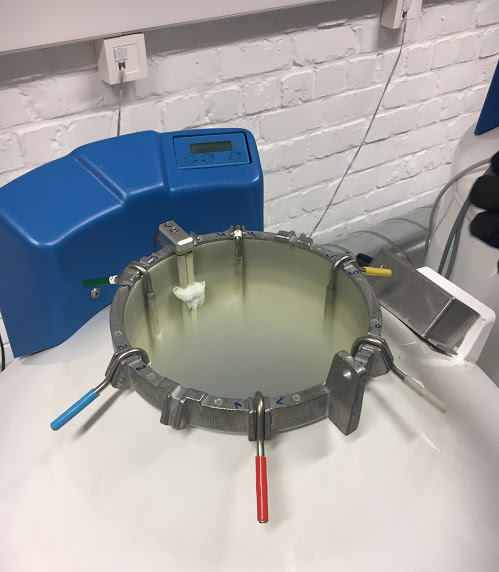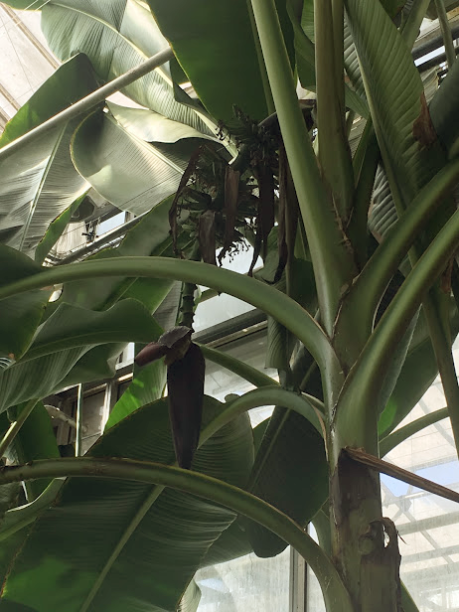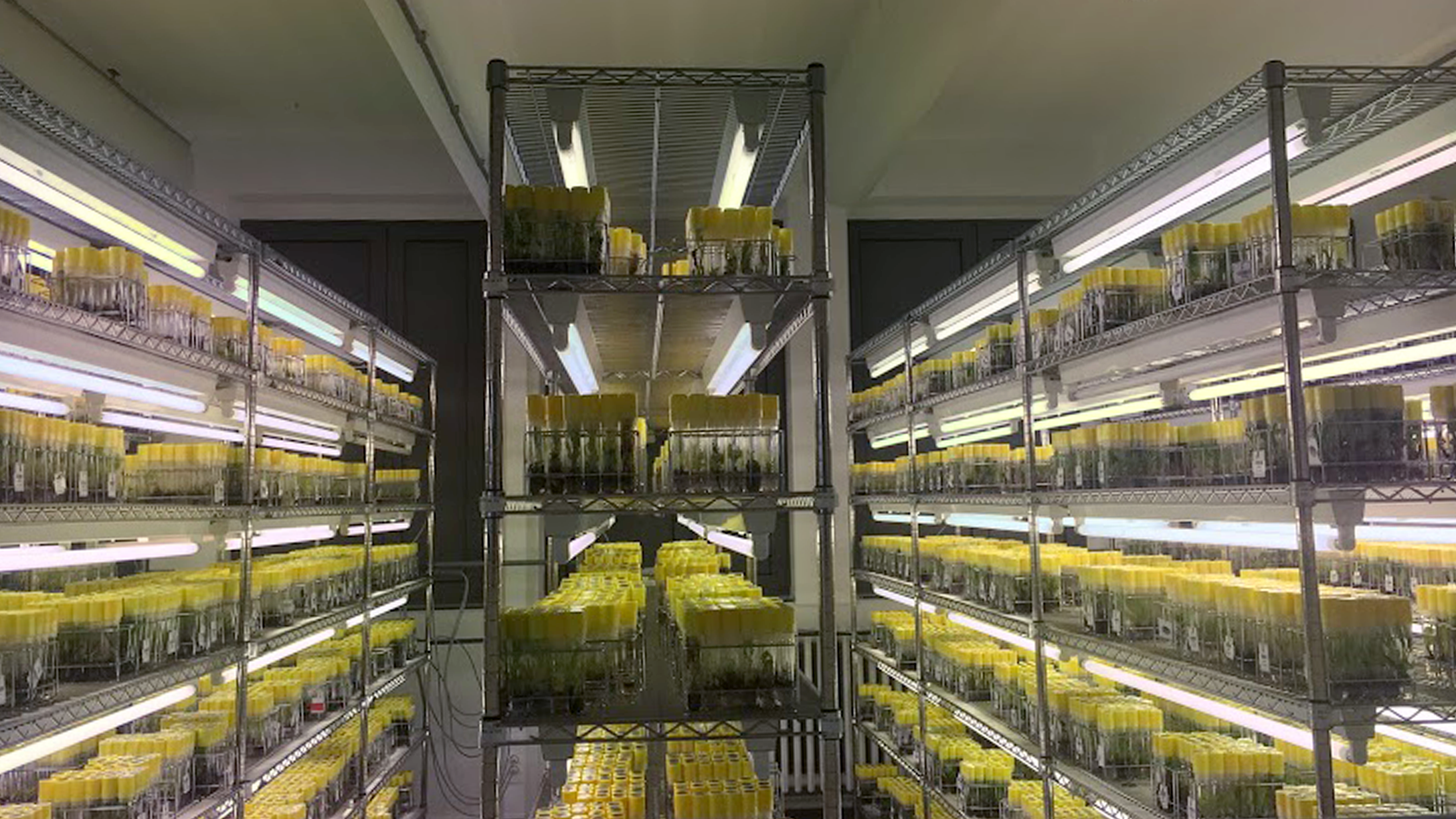1- Meristem excision and loading
Here is how to take something living and bring it to the brink of death. Take a young banana plant of known genotype. Under a binocular microscope, start slicing away leaves until you reach the apical meristem. This is a small mass of undifferentiated stem cells that haven’t yet decided if they will go on to become leaves, flowers, stamens, or fruits. A tiny nub of possibility. Keep cutting—the smaller the better. Slice away, square millimeter by square millimeter, until you can barely see the plant anymore. Until it no longer resembles the thing it was and will perhaps become again.
The International Musa Transit Center, the largest collection of banana germplasm on earth, is built on verdant land that was once a medieval farm. Bart, a Belgian cryopreservation scientist with rounded specs and a jolly demeanor, led me past weathered stone walls centuries old. The faint scent of manure clung to the air. A rip-roaring heat wave had hit most of western Europe just weeks before, but that day in Leuven, Belgium was beautiful: cool but sunny with a handful of picturesque clouds dotting the sky.
Past tall grass, the greenhouse emerged. Huge plants pressed against the insides of the windows, barely registering as dark shapes under steamy glass. Inside, it was humid and smelled of wet earth and growing things. This is where banana plants are grown out, and experiments on climate change adaptation and drought stress are carried out. Lush plants nearly twice the height of an adult filled almost all the negative space; huge arcing leaves the shape of goose feathers. It was quite marvelous.
Bart pointed out a wild crop relative to cultivated bananas growing in the corner of the greenhouse. A plant that was a bit shorter, its leaves a little thinner than those of the other plants. There were fruits nestled in its boughs—a cluster of shockingly bright magenta bananas, hot pink fingers in a bed of dark vital green. The banana plants looked lush, vibrant and strong; their shiny leaves had lighter green ribs that were matte, as if coated with powder. Wider than a man’s torso in the thickest areas, the giant herbs looked like they’d only just burst out of the ground. Their growth was almost audible, their leaves stretching and trunks expanding as new baby leaves unfurled.
Consider the banana. Its velvety, mottled yellow-brown exterior. The wrinkled brown button at its tip, the subtle pleating down its length, like paper once creased and then unfolded. Its gentle curve. Look closer at the soft, feathery texture. Zoom into the sweet flesh and you’ll find blobby cells, each filled with a number of starch vessels, like a bag of pebbles plucked from a stream bed. Past those, you’ll see the nucleus—a smaller, more spherical stone through whose membrane little granules appear.
If you zoom in even closer you’ll see three sets of chromosomes swimming around. Like eyelashes, or stray bits of thread suspended inside the cytoplasm. Three sets, to our two. Three sets, which makes banana plants sterile. Which means that farmers must grow the plants from cuttings instead of seeds. Which leads to fields full of genetically identical cloned plants. Clones, each susceptible in exactly the same way to viruses and fungi, wilt and plague and bugs. Identical disasters, waiting to maybe play out.
2- Dehydration with PVS2 and freezing
You must protect the delicate banana tissue from the trauma of freezing. A cell is, in essence, a small sack of water. Plunk a thing made of cells into a vat of liquid nitrogen and the water will turn rapidly to ice whose crystals puncture the cell walls and cause irreparable damage. Freeze something made of cells, and you drastically change it. If it was alive, there is an excellent chance it won’t be after you thaw it out again. Instead, you should turn the water in the cells to glass. Vitrification, the process is called. Not a solid at all, but a very viscous, very cold liquid. From something green and pliant, to glass—imagine tapping a fingernail against it, the clear peal ringing out in response.
To do that, you’ll need a cryoprotectant—PVS2. A solution that draws the water out of the cells to keep it from crystallizing. Place the tiny bit of banana plant into a droplet of PVS2 on a piece of very cold aluminum foil. The scrap of tissue will bob inside the globe of liquid. Then plunge into liquid nitrogen.
There it will remain, ad infinitum. All metabolic processes halted. No cell division, no respiration. As close to dead as a living thing can get.
 courtesy of the author
courtesy of the authorBananas are vital to the food security of cultures around the world. In Central America, South America and Sub-Saharan Africa, they are a staple food that feeds millions of people. They are a crop with huge genetic diversity. If you know where to look, you can find fruit of widely varying colors and shapes, bananas that taste like apples, or ice cream, savory bananas, tiny green bananas, bright purple ornamental bananas.
Despite this, the Cavendish banana is the most widely exported—the quintessential bright yellow fingers that most Americans and Europeans are familiar with. And they are deeply threatened by the rapid spread of TR4, a fungus that resides in the soil that causes root wilt and kills banana plants. The last time the crop was faced with such a threat, the Gros Michel, the main cultivar for export at the time, was dropped by exporters like Dole and Chiquita in favor of the then-resistant Cavendish. Today the Cavendish and other varieties face an existential threat from TR4, from which there is no protection.
The lighting in the cold room, where the live samples are kept under slow growth conditions, was somehow both dim and painfully bright. Fluorescent tube lights, reminiscent of hospitals or parking garages, were suspended over each shiny metal shelf of rows of plants in clear test tubes. The yellow-capped vials were filled with small green sprouts on a clear medium, roots poking into the colorless jelly. A key role of the International Musa Germplasm Transit Center is to provide virus-free banana tissue to whoever requests it—small-scale farmers or large research universities—at no cost. Some of the vials on the shelves might soon be packaged up in vacuum bags and whisked away to Tanzania or Australia, though such movement was difficult to imagine in the still and silent room. It smelled strongly of fake citrus, a pesticide laid down to kill any stray bugs that might wander in. The cloying artificial smell lingered in the nose and lungs.
The TR4 fungus lives in the soil, penetrates through the roots of the banana plant and makes its way upwards. If you cleave the plant down the middle, you’ll see amongst the light yellow vascular tissue, like bundles of tiny straws that carry water and nutrients up its length, stripes of dark brown ascending. The fungus turns the broad green leaves traffic-sign yellow, then the unmistakable brown of death. The leaves droop towards the ground, then the entire plant bends at the waist. Strangely the gemlike fruit remains untouched by the carnage.
**
TR4 has already decimated tens of thousands of acres of commercial Cavendish banana plantations in Taiwan, Indonesia, and Malaysia. Outbreaks have been reported in almost all banana-producing countries, and there is no known fungicide that can control it. Even as plant pathologists and geneticists rush to find a resistant cultivar to replace the Cavendish, to many this feels like playing catch-up. It appears poised to go the way of the Gros Michel, which devastated entire economies when it was eradicated and by some estimates caused losses of over $2.3 billion worldwide, the equivalent of $24.5 billion today.
T R4’s reach doesn’t end there. It affects varieties that represent over 80% of the world’s banana production. This includes the myriad cultivars grown and eaten locally. In Uganda, the world’s largest consumer of bananas per capita, steamed and mashed matooke plantain is a staple of the daily meal. Gonja bananas are charcoal broiled and sold at roadside stands, bananas are made into waragi gin, and the banana plant’s fibrous leaves are used as thatch, packaging, and woven into baskets and containers. The farms that produce these varieties, and the communities and economies that depend on them all stand to lose much in the looming disaster.
**
The story of bananas is one of constant near-extinction. The magic of the banana bank is that the dead and the alive exist side by side. This juxtaposition is not incidental, but rather the point.
Can freezing be enough in a world that is rapidly warming, in which even the Svalbard Global Seed Vault is melting?
3- Thawing, unloading and regeneration
Someday, maybe years in the future, you will be called upon to reverse the spell and turn this tiny thing back from glass to plant. Unscrew the tank of liquid nitrogen, watch as the substance sublimates and turns things hazy, the gas dissipating upwards. Plunge a metal hook inside, feel for the catch, and lift out the metal box crusted with white. Slide out the tray of 2 ml cryotubes. Remove the one containing the desired banana section and drop it into a warm bath, rapidly raising the temperature and shocking the plant back to life. Rinse off the PVS2, toxic to living tissue at room temperature. Place it on a petri dish, culture in the dark. Wait four to six weeks. Pray.
**
The cryo room of the world’s largest banana bank looks more like someone’s basement than a high-tech mausoleum, or a sterile ark. The walls are made of brick painted a clean matte white. The humming of ten or so large metal tanks fills the room. They are roughly half as tall as an adult and cylindrical in shape, with gently sloping sides going up to a smaller lid. It’s like a little nest with these cold metal eggs, into which we are placing our hopes for the future of bananas. Over one thousand accessions of bananas, held at -196C, dormant until further notice.
 courtesy of the author
courtesy of the authorIf you have managed to keep the delicate bundle of cells alive through the cutting down, the leaching away of water, the transmogrification to glass, the sudden melting into life, you will see new growth. Molecular mechanisms will creak and whir into motion once more. Things will expand, split, replicate. Regeneration, this process is called. Take in the vital green of new growth. Lean in close and focus your gaze till the image doubles, triples before you. Then when it becomes too much to bear, pull back, let them comfortably resolve into one again.






